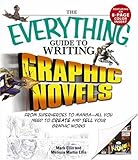
- ISBN13: 9781598694512
- Condition: NEW
- Notes: Brand New from Publisher. No Remainder Mark.
Product Description
Watchmen. V for Vendetta. A History of Violence. The Sandman. 300. You’ve read them, you’ve loved them, and now you want to write and illustrate them. The Everything Guide to Writing Graphic Novels is your shot at the big time. Whether you want to go as dark as Sin City, as funny as Bone, or as poignant as Maus, this book shows you how to do it all. You’ll learn how to: Develop memorable characters Create intricate storylines Illustrate, lay out, and… More >>
Everything Guide to Writing Graphic Novels: From superheroes to manga—all you need to start creating your own graphic works